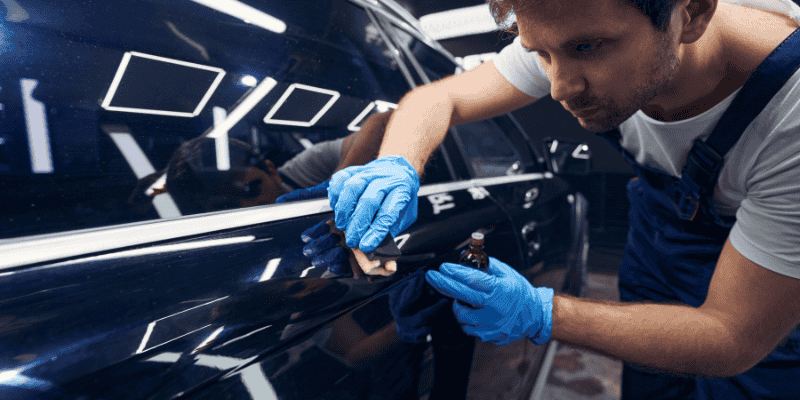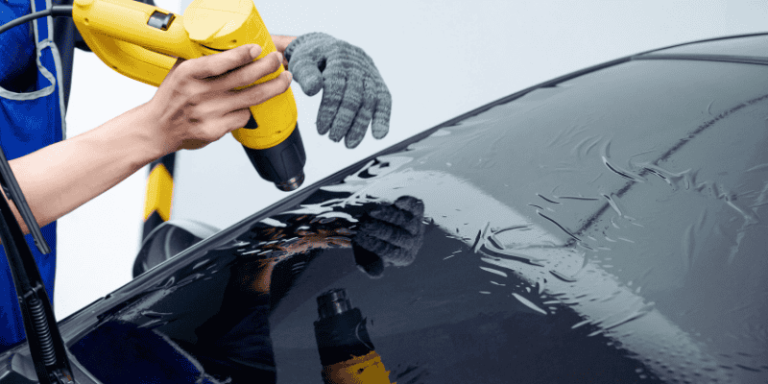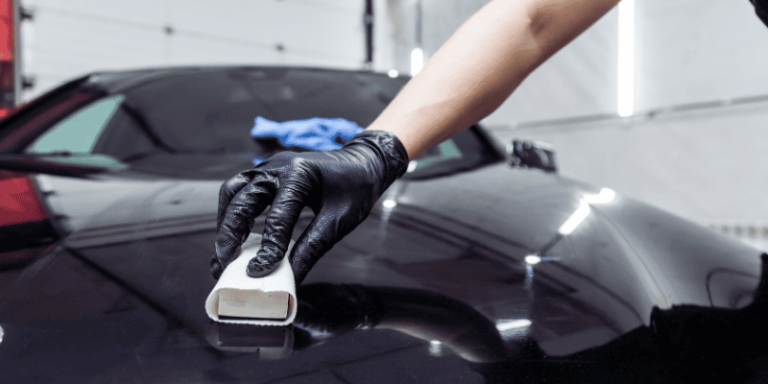When it comes to protecting your vehicle and enhancing its aesthetic appeal, choosing between ceramic tinting and standard window tint is a decision that car owners face frequently. In this comprehensive guide, we break down the differences between ceramic tinting and standard car window tint, examining every aspect from performance to cost. Whether you’re interested in window tinting ceramic for superior heat rejection or considering tinted film on car windows as a budget-friendly option, this article will provide you with the insights needed to make an informed decision.
Understanding Window Tinting: The Basics
What Is Window Tinting?
Window tinting involves applying a thin film to your car’s glass surfaces to reduce heat, glare, and UV exposure. This film for tinting car windows not only enhances privacy but also helps preserve the vehicle’s interior by blocking harmful ultraviolet rays. From standard window tint to advanced ceramic window tinting for cars, these films are designed to suit various needs and budgets.
Why Do People Tint Their Windows?
Car owners choose to tint their windows for several reasons:
- Heat Reduction: Tinting minimizes the amount of solar heat entering the car, making it more comfortable.
- UV Protection: It helps block up to 99% of harmful UV rays, protecting both the car’s interior and your skin.
- Glare Reduction: Reduces the glare from sunlight, enhancing driving safety.
- Aesthetic Appeal: A well-tinted car looks sleek and modern, often increasing its resale value.
- Privacy: Offers enhanced privacy by limiting the view from outside.
What Is Regular Window Tint?
How Regular Tint Works
Regular window tint is typically made from dyed, metalized, or hybrid films. This standard window tint is designed to absorb sunlight and reduce heat build-up within the vehicle. The film is applied to the glass surfaces using a specialized adhesive that bonds it securely, ensuring long-lasting protection and style.
Pros and Cons of Regular Window Tint
Pros:
- Cost-Effective: Regular tint is generally more affordable compared to advanced options.
- Aesthetic Variety: Available in various shades to match your car’s style.
- Privacy: Provides a decent level of privacy without a high price tag.
Cons:
- Heat Rejection: May not offer the same level of heat rejection as more advanced films.
- Durability: Can fade over time and might not be as resilient against scratches.
- Limited UV Protection: While effective, it may not block as many UV rays as higher-end options.
Common Types of Regular Tints
- Dyed Tint: Utilizes dye to absorb heat; it’s the most cost-effective but can fade faster.
- Metalized Tint: Incorporates metal particles to reflect heat; offers better durability but may interfere with electronics.
- Hybrid Tint: Combines the benefits of dyed and metalized films for balanced performance.
What Is Ceramic Window Tint?
How Ceramic Tint Works
Ceramic tinting involves using nano-ceramic particles embedded within the film. Unlike traditional films, window tinting ceramic does not contain metal or dye that fades. Instead, it relies on ceramic particles that provide exceptional heat rejection and UV protection without interfering with electronic signals. This technology makes car ceramic tint a superior option for those seeking the best in quality window tinting.
Advantages of Ceramic Window Tint
- Superior Heat Rejection: Ceramic tint can block a significantly higher percentage of solar heat, keeping the interior cooler.
- Enhanced UV Protection: Offers robust protection against UV rays, preserving both the exterior paint and interior fabrics.
- Clearer Vision: Reduces glare without compromising visibility.
- Durability: Resistant to fading, bubbling, and cracking over time.
- No Signal Interference: Since it lacks metal, it won’t interfere with radio, GPS, or mobile signals.
Why Ceramic Tint Is Considered Superior
The main advantage of ceramic window tinting for cars is its ability to combine performance with longevity. While the initial investment might be higher than that of a standard car window tint, the long-term benefits in terms of durability, heat rejection, and UV protection often justify the extra cost. For car owners who want the best film for tinting car windows without compromising on appearance or functionality, ceramic tint is an excellent choice.
Key Differences Between Ceramic and Regular Tint
To better understand the trade-offs, consider the following detailed comparisons:
Heat Rejection & UV Protection
- Ceramic Tint: Offers advanced heat rejection, keeping the car interior significantly cooler. It blocks a higher percentage of UV rays, protecting both the vehicle’s interior and occupants.
- Regular Tint: Provides moderate heat reduction and UV protection, which may be sufficient in mild climates but less effective in extreme conditions.
Glare Reduction & Visibility
- Ceramic Tint: Reduces glare effectively while maintaining clarity and ensuring safe driving conditions.
- Regular Tint: Also reduces glare, but in some cases, the reduction in light transmission may affect visibility, particularly in lower light conditions.
Durability & Lifespan
- Ceramic Tint: Known for its longevity and resistance to fading, bubbling, and cracking.
- Regular Tint: May degrade over time due to exposure to sunlight and heat, requiring earlier replacement.
Signal Interference Issues
- Ceramic Tint: Since it contains no metal, it does not interfere with electronic signals a significant advantage over some metalized options.
- Regular Tint: Metalized versions can sometimes interfere with radio, GPS, or cellular signals.
Cost Comparison
| Feature | Ceramic Tint | Regular Tint |
| Heat Rejection | Superior; keeps interior cooler | Moderate; effective in mild climates |
| UV Protection | Excellent; blocks higher UV percentage | Good; may block less UV |
| Durability | High; resistant to fading and bubbling | Lower; may fade or bubble over time |
| Signal Interference | None; safe for all electronics | Possible interference with metalized films |
| Cost | Higher initial investment | More affordable upfront |
Is Ceramic Tint Worth It?
When to Choose Ceramic Over Regular Tint
Opt for ceramic tint if you:
- Live in areas with high temperatures and intense sunlight.
- Want maximum UV protection for your vehicle’s interior.
- Prefer a long-lasting solution with minimal maintenance.
- Value clear visibility without the risk of signal interference.
Budget vs Long-Term Investment
While ceramic tinting is more expensive initially compared to standard window tint, its durability and performance can offer significant savings over time. The improved protection means fewer replacements and maintenance issues, making it a smart long-term investment.
Expert Recommendations Based on Climate & Driving Needs
Experts at OC Tint Solutions often recommend ceramic window tinting for cars in regions with extreme weather conditions. However, if you reside in a milder climate or have a limited budget, a high-quality standard car window tint can still offer substantial benefits. The decision should be based on your specific needs, driving habits, and local climate conditions.
Professional vs DIY Tinting: What’s the Best Option?
Cost & Quality Considerations
Professional tint installation is generally recommended for both car ceramic tint and standard window tint. Professionals ensure that the film is applied without bubbles or creases, which is crucial for achieving optimal performance and longevity. While a DIY approach might seem appealing due to lower costs, mistakes can compromise the effectiveness of the tinted film on car windows.
Common DIY Mistakes to Avoid
- Improper Surface Preparation: Dust, dirt, or oil on the glass can cause bubbling.
- Uneven Application: Incorrect alignment or air bubbles can result in a poor finish.
- Using Low-Quality Film: Opting for cheaper films can lead to early fading and poor performance.
Finding a Reputable Tinting Service
For reliable installation, it’s advisable to choose a service with a solid reputation in quality window tinting. OC Tint Solutions is known for its expertise in both ceramic tinting and standard window tint applications, ensuring that every job meets high standards of performance and aesthetics.
Final Verdict: Which Tint Should You Choose?
Best Choice for Budget-Conscious Buyers
If you’re looking for a more affordable solution and live in a moderate climate, standard window tint offers good value. It provides adequate heat reduction and privacy without the higher price tag associated with ceramic films.
Best Choice for Maximum Performance
For those seeking the ultimate in performance, ceramic tinting is the way to go. It offers superior heat rejection, enhanced UV protection, and durability that makes it ideal for extreme weather conditions. This is the best option for car owners who prioritize long-term benefits and quality window tinting.
Long-Term Benefits of Investing in Quality Tint
In summary, the choice between ceramic tint vs regular tint boils down to your specific needs and budget. Investing in a high-quality solution, especially from a trusted provider like OC Tint Solutions, ensures that your vehicle not only looks great but also stays protected against harsh environmental conditions. Whether you choose car ceramic tint or opt for a more traditional standard car window tint, you’re taking a proactive step toward preserving your vehicle’s value and comfort.




